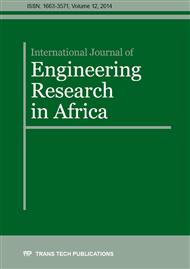[1]
Z. Jin, X. Jie, Architecture and application of integrated spatial information service platform for digital mine, Trans. Nonferrous. Met. Soc. China 21 (2011) 706–711.
Google Scholar
[2]
V. Gischig, F. Amann, J.R. Moore, S. Loew, H. Eisenbeiss, W. Stempfhuber, Composite rock slope kinematics at the current Randa instability, Switzerland, based on remote sensing and numerical modeling, Eng. Geol. 118 (2011) 37–53.
DOI: 10.1016/j.enggeo.2010.11.006
Google Scholar
[3]
N. Gerolymos, Numerical modeling of seismic triggering, evolution, and deposition of rapid landslides: Application to Higashi-Takezawa (2004), Int. J. Numer. Anal. Methods Geomech. 34 (2010) 383–407.
DOI: 10.1002/nag.812
Google Scholar
[4]
Z. Li, X. Yan. C. Yuan, Z. Peng, L. Li, Virtual prototype and experimental research gear multi—fault diagnosis using wavelet—autoregressive model and principal component analysis method, Mech. Syst. Signal Process. 25 (2011) 2589–2607.
DOI: 10.1016/j.ymssp.2011.02.017
Google Scholar
[5]
A. Brahme, M. Winning, D. Raabe, Prediction of cold rolling texture of steels using an Artificial Neural Network, Comput. Mater. Sci. 46 (2009) 800–804.
DOI: 10.1016/j.commatsci.2009.04.014
Google Scholar
[6]
T. Kanamori, Deformation of log-likelihood loss function for multiclass boosting, Neural. Netw. 23 (2010) 843–864.
DOI: 10.1016/j.neunet.2010.05.009
Google Scholar
[7]
K. Yan, C. Shi, Prediction of elastic modulus of normal and high strength concrete by support vector machine, Constr. Build. Mater. 24 (2010) 1479–1485.
DOI: 10.1016/j.conbuildmat.2010.01.006
Google Scholar
[8]
Z. Li, X. Yan, Z. Guo, C. Yuan, Z. Peng, A new intelligent fusion method of multi-dimensional sensors and its application to tribo-system fault diagnosis of marine diesel engines, Tribol. Lett. 47 (2012) 1–15.
DOI: 10.1007/s11249-012-9948-1
Google Scholar
[9]
M. Paliwal, U. Kumar, Neural networks and statistical techniques: A review of applications, Expert Syst. Appl. 36 (2009) 2–17.
Google Scholar
[10]
Z. Li, X. Yan, Z. Guo, Y. Zhang, C. Yuan, Z. Peng, Condition monitoring and fault diagnosis for marine diesel engines using information fusion techniques, Elektronika ir Elektrotechnika 123 (2012) 109–112.
DOI: 10.5755/j01.eee.123.7.2387
Google Scholar
[11]
G. Huang, L. Chen, Enhanced random search based incremental extreme learning machine, Neurocomputing 71 (2008) 16–18.
DOI: 10.1016/j.neucom.2007.10.008
Google Scholar
[12]
C. Lian, Z. Zeng, W. Yao, H. Tang, Displacement prediction model of landslide based on a modified ensemble empirical mode decomposition and extreme learning machine, Nat. Hazard. 66 (2013) 759–771.
DOI: 10.1007/s11069-012-0517-6
Google Scholar
[13]
T. Tsai, The influence of rainstorm pattern on shallow landslide, Environ. Geol. 53 (2008) 1563–1569.
DOI: 10.1007/s00254-007-0767-x
Google Scholar
[14]
S. Martelloni, R. Fanti, F. Catani, Rainfall thresholds for the forecasting of landslide occurrence at regional scale, Landslides 9 (2012) 485–495.
DOI: 10.1007/s10346-011-0308-2
Google Scholar
[15]
E. Arnone, L. Noto, C. Lepore, R. Bras, Physically-based and distributed approach to analyze rainfall-triggered landslides at watershed scale, Geomorphology 133 (2011) 121–131.
DOI: 10.1016/j.geomorph.2011.03.019
Google Scholar
[16]
G. Acharya, T. Cochrane, T. Davies, E. Bowman, The influence of shallow landslides on sediment supply: A flume-based investigation using sandy soil, Eng. Geol. 109 (2009) 161–169.
DOI: 10.1016/j.enggeo.2009.06.008
Google Scholar
[17]
Y. Zhang, P. Zhang, Optimization of nonlinear process based on sequential extreme learning machine, Chem. Eng. Sci. 66 (2011) 4702–4710.
DOI: 10.1016/j.ces.2011.06.030
Google Scholar
[18]
D. Tarchi, N. Casagli, R. Fanti, D. Leva, G. Luzi, A. Pasuto, M. Pieraccini, S. Silvano, Landslide monitoring by using ground-based SAR interferometry: An example of application to the Tessina landslide in Italy, Eng. Geol. 68 (2003) 15–30.
DOI: 10.1016/s0013-7952(02)00196-5
Google Scholar
[19]
L. Noferini, T. Takayama, M. Pieraccini, D. Mecatti, G. Macaluso, G. Luzi, C. Atzeni, Analysis of ground-based SAR data with diverse temporal baselines, IEEE Trans. Geosci. Remote Sens. 46 (2008) 1614–1623.
DOI: 10.1109/tgrs.2008.916216
Google Scholar


